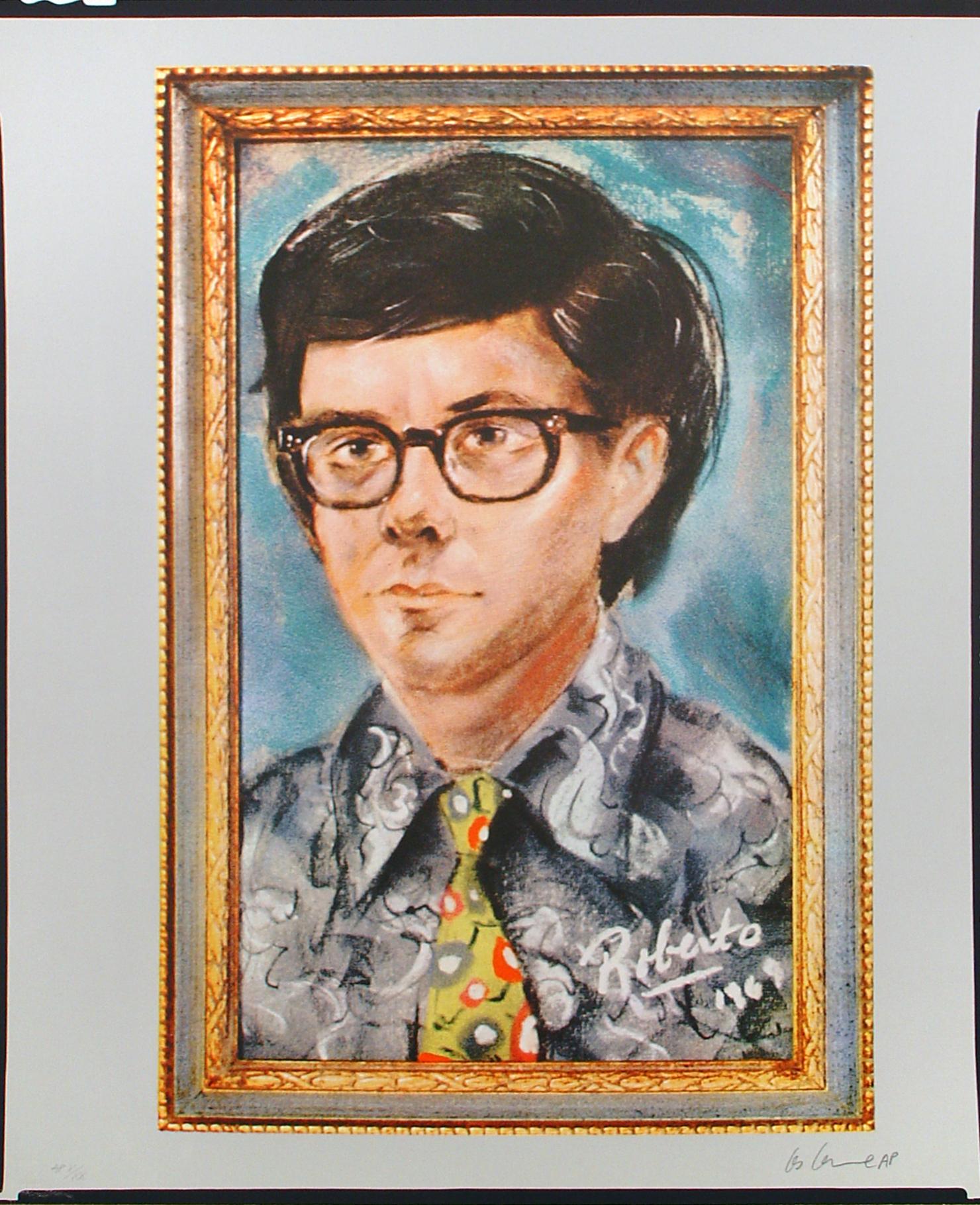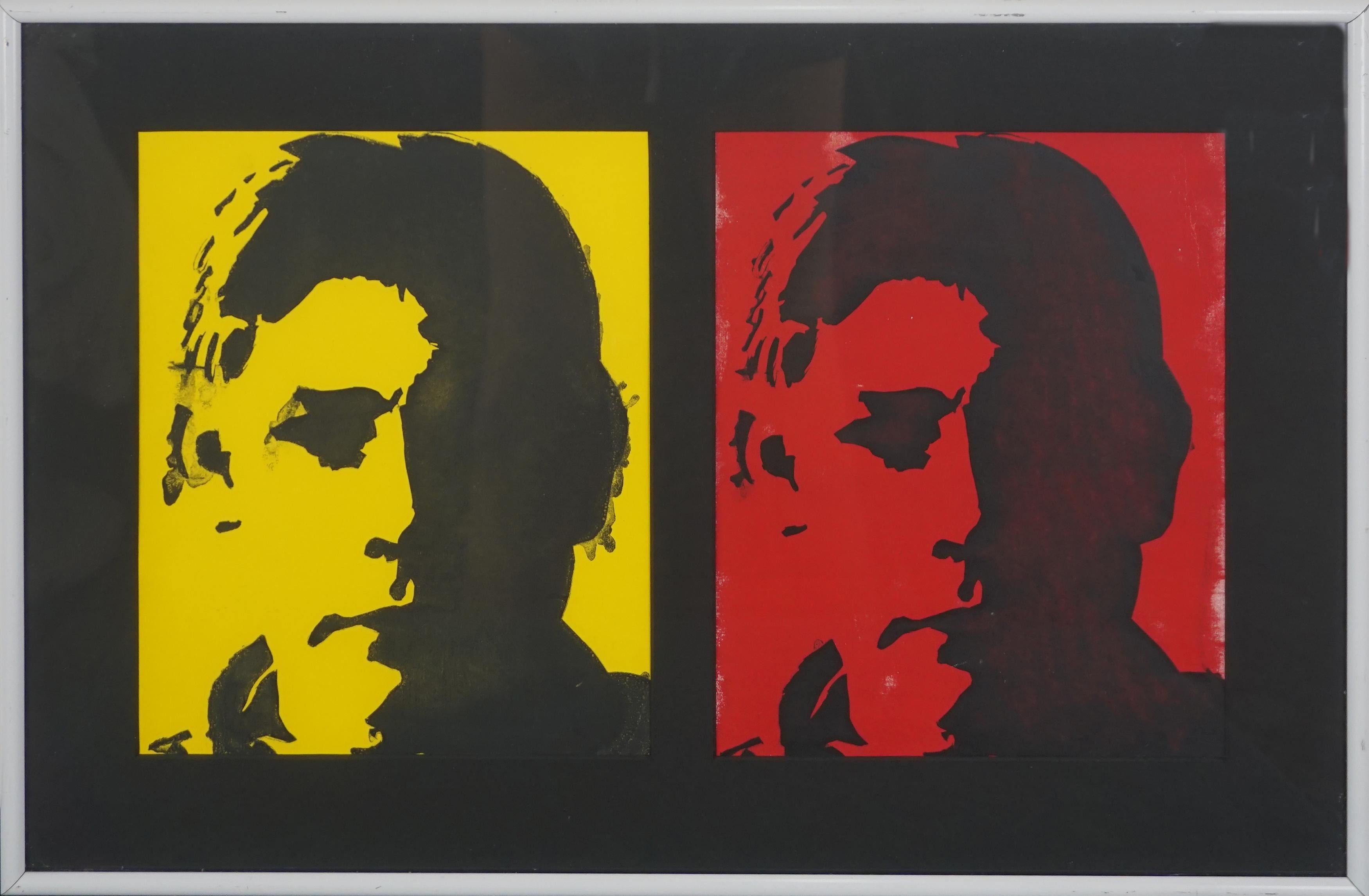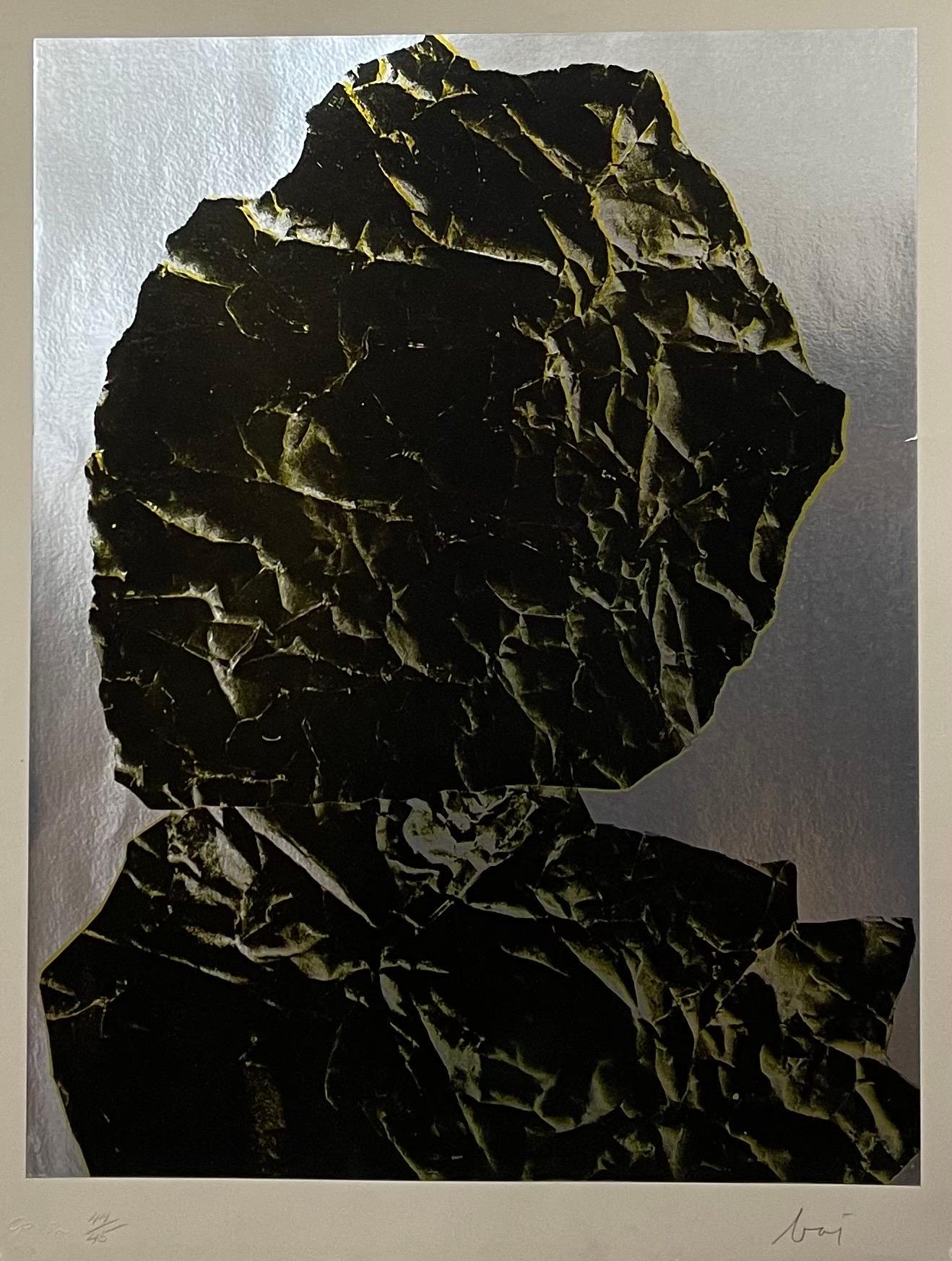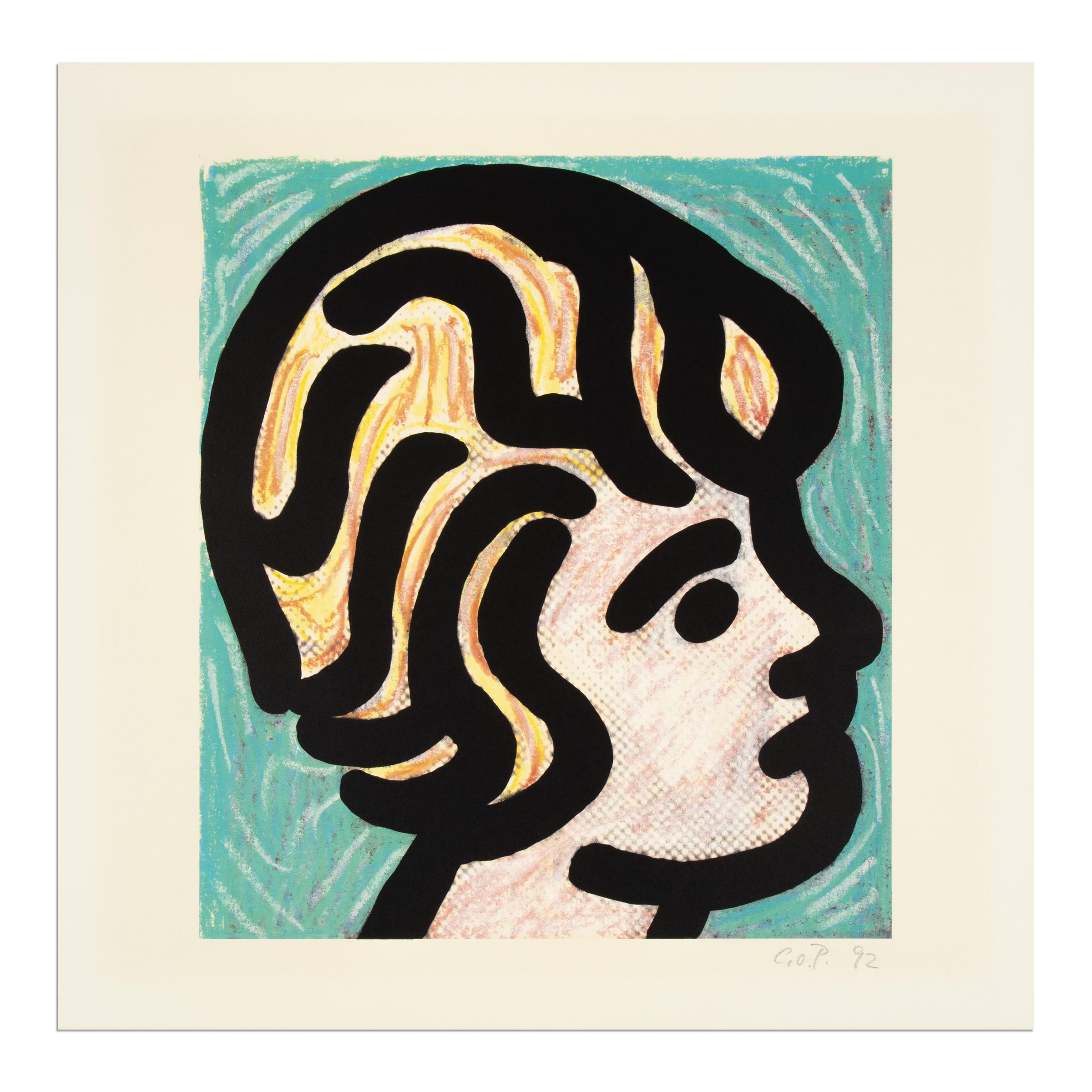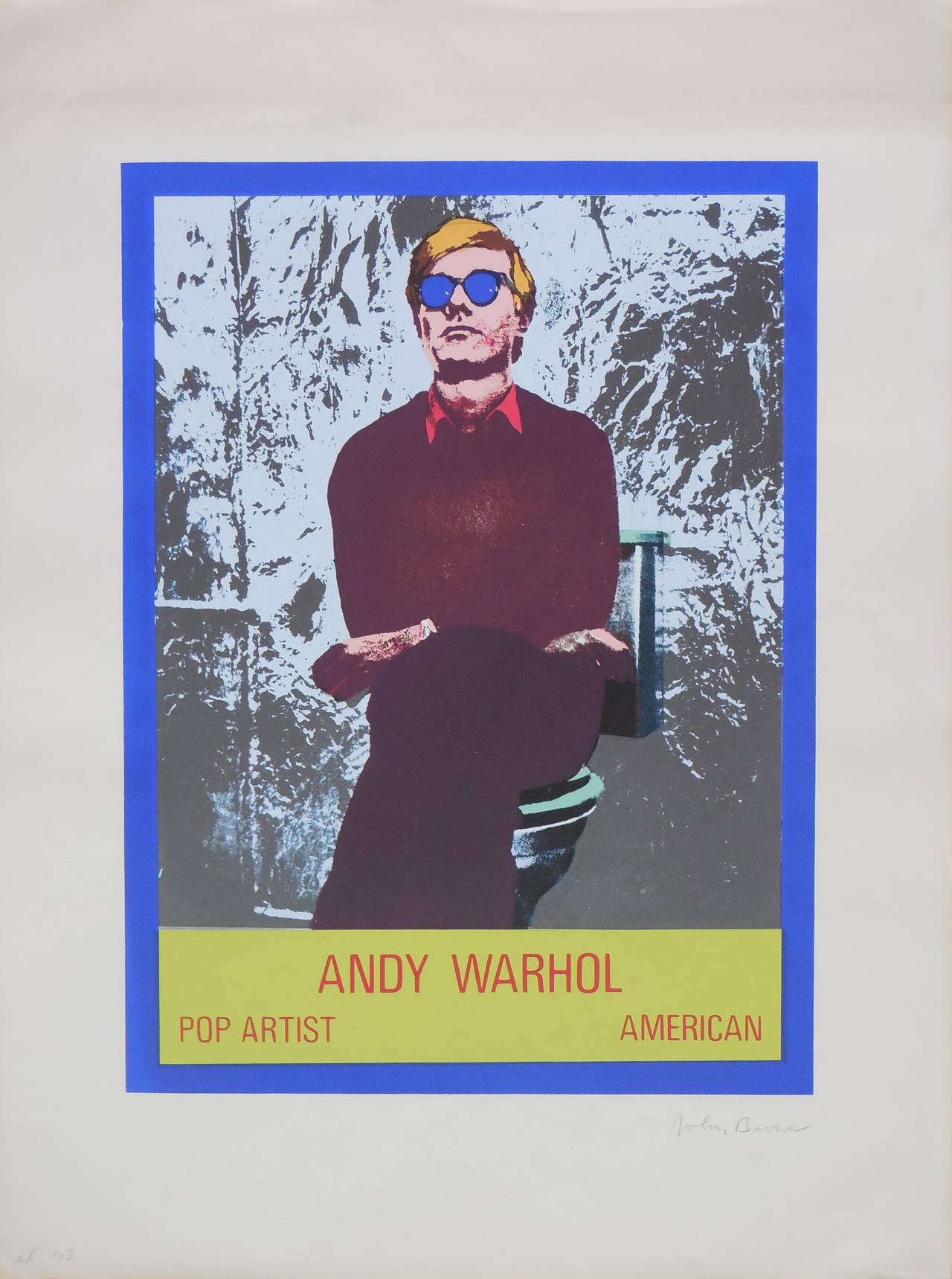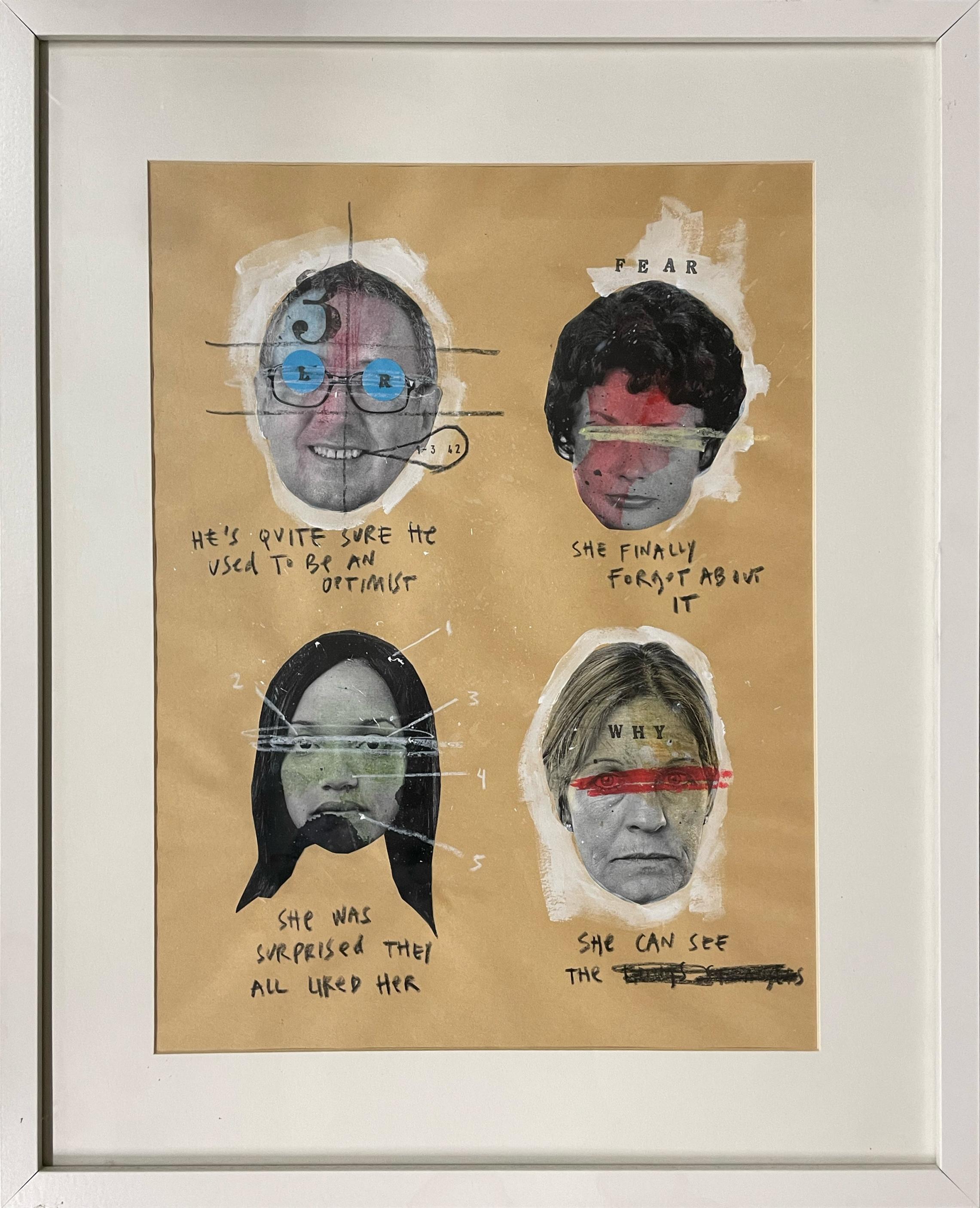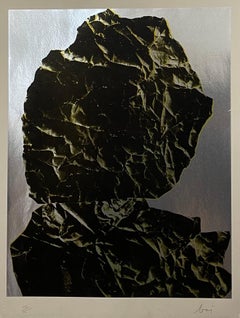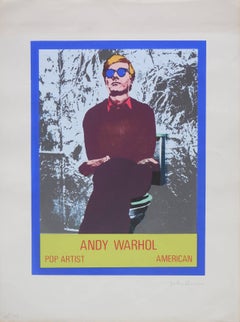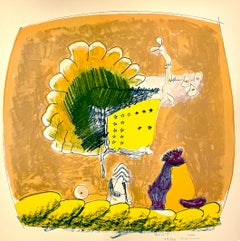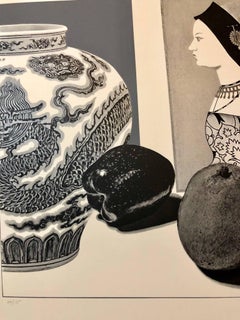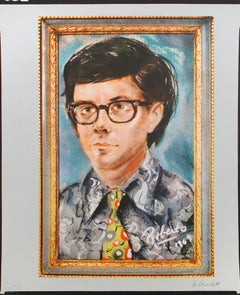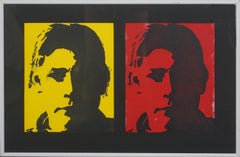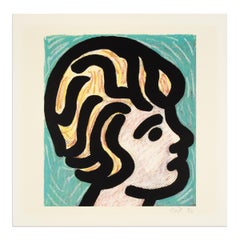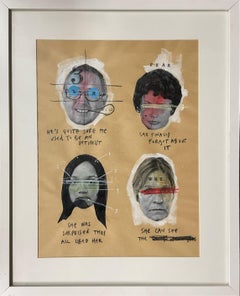Items Similar to Color Silkscreen Pop Art Lithograph Print Les Levine Canadian Pop Art Portrait
Want more images or videos?
Request additional images or videos from the seller
1 of 8
Les LevineColor Silkscreen Pop Art Lithograph Print Les Levine Canadian Pop Art Portrait1969-1971
1969-1971
$850
£649.04
€738.96
CA$1,193.53
A$1,304.77
CHF 690.28
MX$15,613.63
NOK 8,782.82
SEK 8,039.79
DKK 5,519.57
About the Item
Les Levine
On the Bowery, 1969 - 1971
Screenprint in color
25.5 x 25.5 inches, signed, numbered 21/100
Hand signed, published by Edition Domberger, Bonlanden, West Germany (with their blindstamp)
Provenance: Collection of Tom Levine
On the Bowery, 1971. The portfolio consists of nine screenprints in colors (one with mylar collage), on wove paper, by representative artists of the Pop Art period. Cy Twombly, Robert Ryman, Will Insley, Robert Indiana, Les Levine, John Willenbecher, Charles Hinman, Richard Smith, Gerald Laing, and John Giorno. The ten artists were photographed by Eliot Elisofon (1911-1973), who also lived on the Bowery and was a founding member of the Photo League in 1936.
In the late 40s and 50s Clyfford Still, Mark Rothko, Fernand Leger and Jean Dubuffet, among others, had studios on the Bowery, and Willem de Kooning, Franz Kline and Reginald Marsh worked nearby. In the early 60s, Louise Nevelson took a place on Mott Street just off the Bowery and was joined not long after by other artists attracted by the lofts for reasonable rents and the relaxed, small-time quality of the area. - William Katz, from the introduction for the portfolio.
Among other artists, writers and photographers who have lived or worked there are: Arman, Jack Brusca, Larry Calcagno, Pierre Clerk, Tom Doyle, Jean Dupuy, Janet Fish, Robert Frank, Adolph Gottlieb, Eva Hesse, Roy Lichtenstein, Jay Maisel, Ed Meneeley, Malcolm Morley, Kenneth Noland, Angelo Savelli, and Tom Wesselmann.
Les Levine (born 1935) is a naturalized American Irish artist known as a pioneer of video art and as a conceptual artist working with mass communication. In 1967, Levine won first prize for sculpture in the Canadian Sculpture Biennial.
A graduate of the Central School of Art and Design in London, Levine first moved to Canada in 1960. He eventually settled in New York City in 1964 and became a resident artist at the Nova Scotia College of Art and Design in Halifax, Nova Scotia in 1973. Early in his career, Levine introduced the idea of a disposable art and was given the nickname Plastic Man. In 1965, Levine, with Nam June Paik, were among the first artists to buy and use portapaks. Thus he was one of the first artists to try television as a medium for the dissemination of art. He has also used the telephone for this purpose, as well. In 1969 he exhibited White Sight at the Fischbach Gallery, a work consisting of a room as the inside of a featureless white cube illuminated by two bright sodium vapour lights. This meant that the spectator was confronted with their own act of looking presented as an artifact. The installation was also included as a feature for a charity ball at the New York Museum of Modern Art, to attend which museum patrons had to pay $75 per couple. Whilst Levine regarded the installation as a great success, this view was not shared by all the patrons. The yellow light drained the women's dresses of color. One visitor said: "All the men looked as if they have been dead for two centuries. All the women looked like their grandmothers. The beautiful ladies fled within one minute." One of these accused Levine of making the museum "look ugly and silly" and promptly transformed the artwork by pulling the main light switch. In 1984, Levine produced the short film Made in New York in collaboration with fashion designer Willi Smith. He also designed a T-shirt for Smith’s label WilliWear Productions that was featured in the film. Levine has written on art for Arts, The Village Voice, Art in America and the Saturday Review. He was awarded the National Endowment for the Arts Fellowship in 1974 and again in 1980.
Reference material
Expanded Cinema by Gene Youngblood (pp. 337–344). Beyond Modern Sculpture by Jack Burnham, The Britannica Encyclopedia of American Art Simon Schuster, Art and the Future by Douglass Davis, Science and Technology in the Arts by Stewart Kranz, Innovative Printmaking by Theima P. Newman and On Photography by Susan Sontag.
- Creator:Les Levine (1935, Canadian)
- Creation Year:1969-1971
- Dimensions:Height: 25.5 in (64.77 cm)Width: 20.5 in (52.07 cm)
- Medium:
- Movement & Style:
- Period:
- Condition:good. minor wear. never framed. kept in original portfolio.
- Gallery Location:Surfside, FL
- Reference Number:1stDibs: LU38216673612
About the Seller
4.9
Platinum Seller
Premium sellers with a 4.7+ rating and 24-hour response times
Established in 1995
1stDibs seller since 2014
1,845 sales on 1stDibs
Typical response time: 1 hour
- ShippingRetrieving quote...Shipping from: Surfside, FL
- Return Policy
More From This Seller
View AllItalian Surrealist Pop Art Serigraph Enrico Baj Pop Art Silkscreen Foil Print
By Enrico Baj
Located in Surfside, FL
Enrico Baj (1924-2003) Italian, limited edition print.
Hand signed and numbered Signature on the corner. Edition 44 of 45. metallic silver aluminum.
Baj was an Italian artist best k...
Category
1970s Surrealist Figurative Prints
Materials
Foil
Vintage 1960s Andy Warhol Photo Silkscreen Serigraph Pop Art
By John Brower
Located in Surfside, FL
This is for a Photo Silkscreen Serigraph it is Titled Andy Warhol :Pop Artist American. light creasing to paper outside of image
John Brower worked in Chicago as a billboard designer for 12 years. He taught art at Alverno College of Milwaukee, Wright Junior College in Chicago, the University of Illinois, and the University of Kentucky. A Pop Artist.
In John Browers' work two important things come forward: the design and the image. In the painting Indian...
Category
1960s Pop Art Figurative Prints
Materials
Screen
California Pop Art Abstract Expressionist LA Lithograph John Altoon About Women
Located in Surfside, FL
Hand signed and numbered
About Women
Printed by Kenneth E. Tyler; published by Gemini G.E.L.
John Altoon (1925 - 1969), an American artist, was born in Los Angeles to immigrant Arm...
Category
1960s Pop Art Abstract Prints
Materials
Lithograph
Still Life with Hans Maler Pop Art Serigraph Hand Signed
By Josef Levi
Located in Surfside, FL
On deckle edged watermarked Arches French paper. hand signed in pencil, dated and numbered. the edition size is 175.
there are three states of the same image image each with increasing detail and color. This is just for the one in the photo.
Josef Alan Levi (1938) is an American artist whose works range over a number of different styles, but which are unified by certain themes consistently present among them. Josef Levi began his artistic career in the 1960s and early '70s, producing highly abstract and very modernist pieces: these employing exotic materials such as light fixtures and metallic parts. By 1975, Levy had transitioned to painting and drawing still lifes. At first these were, traditionally, of mundane subjects. Later, he would depict images from art history, including figures originally created by the Old Masters. Around 1980, he made another important shift, this time toward creating highly precise, though subtly altered reproductions of pairs of female faces which were originally produced by other artists. It is perhaps this work for which he is most well known. Since around 2000, Josef Levi has changed the style of his work yet again: now he works entirely with computers, using digital techniques to abstract greatly from art history, and also from other sources.
Levi's works of art in the collections of the Museum of Modern Art, NYC, the National Gallery of Art, and the Albright-Knox Museum, among many others. Levi's art has been featured on the cover of Harper's Magazine twice, once in June 1987, and once in May 1997.
Josef Levi received a Bachelor of Arts degree in 1959 from the University of Connecticut, where he majored in fine arts and minored in literature. From 1959 to 1960, he served to a first lieutenant in the U.S. Army, and from 1960 through 1967 he was in the U.S. Army Reserves.
In 1966, he received the Purchase Award from the University of Illinois in 1966, and he was featured in New Talent U.S.A. by Art in America. He was an artist in residence at Appalachian State University in 1969, taught at Farleigh Dickenson University in 1971 and was a visiting professor of art at Pennsylvania State University in 1977. From 1975 to 2007, Levi resided in New York City. He now lives in an apartment in Rome, where he is able to paint with natural light as he was unable in New York.
From 1959 to 1960, Josef took some courses of Howard McParlin Davis and Meyer Schapiro at Columbia University which initiated him into the techniques of reproducing the works of the Old Masters. His first works, created in the 1960s, were wood and stone sculptures of women. His first mature works were abstract pieces, constructed of electric lights and steel.
In 1970, Levi's materials included fluorescent light bulbs, Rust-Oleum and perforated metal in addition to paint and canvas.
By 1980, Josef Levi's art had transformed into a very specific form: a combination of reproductions of female faces which were originally depicted by other artists. The faces which he reproduces may be derived from either portraits or from small portions of much larger works; they are taken from paintings of the Old Masters, Japanese ukiyo-e, and 20th-century art. Artists from whom he has borrowed include: Vermeer, Rembrandt, Piero della Francesca, Botero, Matisse, Utamaro, Correggio, Da Vinci, Picasso, Chuck Close, Max Beckmann, Pisanello, Lichtenstein. The creation of these works is informed by Levi's knowledge and study of art history.
Josef Levi's paintings from this period are drawn, then painted on fine linen canvas on wooden stretchers. The canvas is coated with twenty-five layers of gesso in order to produce a smooth surface on which to work. The drawing phase takes at least one month. Levi seals the drawing with acrylic varnish, and then he may apply layers of transparent acrylic in order to approximate the look of old paintings. After the last paint is applied, another layer of acrylic varnish is sprayed on to protect the work.
Most of the figures in his contemporary pieces are not paired with any others.
SELECTED COLLECTIONS
MUSEUM OF MODERN ART, NEW YORK, NY
ALBRIGHT- KNOX GALLERY, BUFFALO, NY
ALDRICH MUSEUM OF CONTEMPORARY ART, RIDGEFIELD, CT
NATIONAL GALLERY OF ART, WASHINGTON, DC
BROOKLYN MUSEUM OF ART, BROOKLYN, NY
SMITHSONIAN NATIONAL MUSEUM OF AMERICAN HISTORY, WASHINGTON, DC
CORCORAN GALLERY, WASHINGTON, DC
UNIVERSITY OF NOTRE DAME ART...
Category
1970s Pop Art Figurative Prints
Materials
Lithograph, Screen
1970s Modernist Swiss Colorful Surrealism Signed Dada Lithograph Andre Thomkins
By André Thomkins
Located in Surfside, FL
This one is untitled and depicts a portrait of a young woman in yellow, red and blue with a Maryan like quality to it.
Published by Edition Hansjörg Mayer, Stuttgart They published concrete poetry and art books by Mark Boyle, Richard Hamilton, Dorothy Iannone, John Latham, Tom Phillips, Dieter Roth, André Thompkins and Emmett Williams, to name just a few.
André Thomkins (1930 - 1985) was a Swiss painter, illustrator, and poet. He attended art-school, taught by Max von Moos, 1947 – 1949 and the Académie de la Grande Chaumière, Paris, France, 1950. From 1952, he lived in Germany and taught at the Kunstakademie Düsseldorf between 1971 and 1973.
Thomkins painted and drew ironic and fantastic pictures influenced by surrealism and dadaism. Together with Dieter Roth and Daniel Spoerri he prepared works of Eat Art. He also was a writer of palindromes. His friends and collaborators included Daniel Spoerri, Dieter Roth, George Brecht, Richard Hamilton and Karl Gerstner, Thomkins gained a reputation as an ‘artist’s artist’, and is considered one of the most important Swiss artists of the second half of the twentieth century.He died in 1985.
His work is currently represented by Hauser & Wirth Zurich, Switzerland.
Select group exhibitions:
2018
Kunsthalle Krems, 'Pablo Picasso. Arshile Gorky, Andy Warhol. Sculptures and Works on Paper. Hubert Looser Collection', Krems, Austria
2017
Kunsthandel Wolfgang Werner, 'Martin Barré, Karl Otto Götz, Ernst Wilhelm Nay, André Thomkins',
Berlin, Germany
2013
Fabian & Claude Walter Galerie, 'Schweizer Avantgarde Kunst nach 1940', Zurich, Switzerland
2009
The Modern Institute, 'Thomas Houseago, Dieter Roth, Andre Thomkins', Glasgow, England
Museum of Modern Art, 'Compass in Hand: Selections from the Judith Rothschild Collection', NYC
2004
Kunsthandel Wolfgang Werner, 'Arman, Baumeister, Götz, Graubner, Tàpies, Thomkins', Berlin,
Germany
1994
Kunstmuseum Solothurn, 'Eine Schenkung. Grafik von Eduardo Chillida, Antoni Tàpies, Alexander Calder, Jean Dubuffet, Ben Nicholson, Giacometti, Tinguely, Thomkins', Solothurn, Switzerland
1992
Galerie Littmann, Tinguely zu Ehren. A Tribute to Jean Tinguely. Hommage à Tinguely, Basel,
1988
Museum Ludwig, 'Uebrigens sterben immer die anderen. Marcel Duchamp und die Avantgarde seit
1950', Cologne, Germany
1987
Aargauer Kunsthaus, 'Otto Grimm. Marc-Antoine Fehr. Christoph Gredinger', Aarau, Switzerland
Cercle Municipal, 'Art contemporain suisse. Collection de la Banque du Gothard', Luxembourg,
1985
Centre national d'art et de culture Georges Pompidou, 'Livres d'artistes', Paris, France
Rathaus, 'Claude Sandoz – Hans Schärer...
Category
1970s Dada Figurative Prints
Materials
Lithograph, Offset
Lithograph Print Pattern & Decoration Art Honor Father & Mother Robert Kushner
By Robert Kushner
Located in Surfside, FL
Robert Ellis Kushner (American, b.1949).
44/84 Lithograph on paper titled " Honor thy Mother and Father"; Depicting a husband and wife (I have seen this print described as a screenprint and as a lithograph)
Hand signed in pencil and dated alongside an embossed pictorial blindstamp of a closed hand with one raised index finger. Solo Press.
From The Ten Commandments Kenny Scharf; Joseph Nechvatal; Gretchen Bender; April Gornik; Robert Kushner; Nancy Spero; Vito Acconci; Jane Dickson; Judy Rifka; Richard Bosman and Lisa Liebmann.
Robert Kushner, born in 1949, in California, lives in New York, and is a painter and sculptor. He gained attention in the early seventies as a performance artist, using food, fabric and nudity. Kushner was associated with the Pattern and Decoration movement and used fabric collage in large-scale, bold paintings of the figure. Since 1987 he has used flowers as the subject of his paintings, more recently adding a cornucopia of fruits and vegetables to his repertoire. Kushner's use of rich color harmonies and bold, fluid drawing, mark his belief in the importance of beauty in our lives. Kushner draws from a unique range of influences, including Islamic and European textiles, Henri Matisse, Georgia O'Keeffe, Charles Demuth, Pierre Bonnard, Tawaraya Sotatsu, Ito Jakuchu, Qi Baishi, and Wu Changshuo. Kushner’s work combines organic representational elements with abstracted geometric forms in a way that is both decorative and modernist. Kushner has collaborated with Master printer Bud Shark since 1982 on various monotypes and lithographs. These exuberant, sensuous prints often include collage elements, including glitter, chine-collé, metal leaf and hand coloring.
Kushner's work has been exhibited extensively in the United States, Europe, and Japan and has been included in the Whitney Biennial three times and twice at the Venice Biennale in Italy. He was the subject of solo exhibitions at both the Whitney Museum of American Art and the Brooklyn Museum. A mid-career retrospective of his work was organized by the Philadelphia Institute of Contemporary Art. He was one of the original painters of the Pattern and Decoration movements of the 1970s. (along with Cynthia Carlson, Brad Davis, Mary Grigoriadis, Joyce Kozloff, Robert Kushner, Kim MacConnel, Sonya Rapoport, Miriam Schapiro and Valerie Jaudon) The group began exhibiting together in 1976 in "Ten Approaches to the Decorative" at the Alessandra Gallery in New York, followed by "Pattern Painting" in 1977 at PS1 in Long Island City, Queens. Subsequently, over fifty group exhibitions featuring the founding artists were held in museums and galleries in Europe and the U.S. including the National Gallery of Art in Washington, D.C., the Art Institute of Chicago, Palais des Beaux Arts, Brussels, Louisiana Museum of Modern Art in Humlebaek, Denmark, the Neue Galerie, in Aachen, Germany, the Pori Art Museum, the Mayor Gallery in London, Modern Art Oxford, and the Hudson River Museum in Yonkers, New York.Robert Kushner's prints include a lithograph with gold leaf titled White Lilac and a series of monotypes that include Blue Bells II, Geranium IV, and Oregon Grape III. Robert Kushner lives in New York and has completed several major public commissions. He has exhibited his work widely and is represented in the collections of The Brooklyn Museum, Los Angeles County Museum, The Metropolitan Museum, NY, The San Francisco Museum of Modern Art, The Tate Gallery, London, The Whitney Museum, NY and others.
In 1997 Hudson Hills Press published the monograph, Robert Kushner: Gardens of Earthly Delight by Alexandra Anderson-Spivey. The New Jersey Center for Visual Arts mounted the survey exhibition Robert Kushner: 25 Years of Making Art in 1998.
Kushner's work is represented in numerous important public collections:
Albright-Knox Art Gallery, Buffalo, NY
Art Collection of the United States Embassy, Panama
Australian National Gallery, Canberra, Australia
The Baltimore Museum of Art, Baltimore, MD
Bowdoin College Museum of Art, Brunswick, ME
The Brooklyn Museum of Art, Brooklyn, NY
California Palace of the Legion of Honor, San Francisco, CA
Carnegie Museum of Art, Pittsburgh, PA
The Columbus Museum of Art, Columbus, OH
The Contemporary Museum, Honolulu, HI
The Corcoran Gallery of Art, Washington, DC
Galleria degli Ufizzi, Florence, Italy
Gröninger Museum, Gröningen, the Netherlands
Honolulu Academy of Arts, Honolulu, Hawaii
J. Paul Getty Trust, Los Angeles, CA
Library of Congress, Washington, D.C.
Los Angeles County Museum of Art, Los Angeles, CA
The Metropolitan Museum of Art, New York, NY
Museum Ludwig, Cologne, Germany
Museum Ludwig, St. Petersburg, Russia
Museum Moderner Kunst - Palais Lichtenstein, Vienna, Austria
The Museum of Modern Art, New York, NY
The National Gallery of Art, Washington, D.C.
Neue-Galerie-Sammlung Ludwig, Aachen, Germany
Philadelphia Museum of Art, Philadelphia, PA
Rockefeller Center, New York, NY
San Francisco Museum of Modern Art, San Francisco, CA
The Tate Gallery, London, England
Whitney Museum of American Art, New York, NY
Select Exhibitions:
Robert Kushner: 30 Literary Nudes, Luis De Jesus, Santa Monica, CA
Robert Kushner: The Language of Flowers, DC Moore...
Category
1980s Contemporary Figurative Prints
Materials
Lithograph, Screen
You May Also Like
UNTITLED (from the ON THE BOWERY portfolio)
Located in New York, NY
screenprint in colors AP V/XX ed.100
ON THE BOWERY, West Germany, Edition Domberger
Category
1970s Modern Portrait Prints
Materials
Screen
Pop Art Male Diptych Silkscreen Portrait
Located in Soquel, CA
Wonderful diptych silkscreen of man in yellow and red by unknown artist, circa 2000. Unsigned. Presented in white metal frame under glass. Originally sold by Walters Adams Gallery. E...
Category
Early 2000s Pop Art Portrait Prints
Materials
Paper, Ink
$360 Sale Price
20% Off
C.O. Paeffgen, Untitled - Signed Print, 1992, Pop Art, Portrait
Located in Hamburg, DE
C.O. Paeffgen (German, 1933-2019)
Untitled, 1992
Medium: Offset lithograph on card stock
Dimensions: 49.5 x 50 cm
Edition of 100: Monogrammed, numbered and dated
Condition: Very good
Category
20th Century Pop Art Portrait Prints
Materials
Offset
Close Before Striking IX. Mixed Media Abstract Portraits on Paper
By Roberto Fonfria
Located in Miami Beach, FL
Fonfria's work explores human behavior and social rules with a critical eye and humor, touching on personal themes such as dreams, fears, and memories. The images come from old magazines...
Category
2010s Pop Art Mixed Media
Materials
Cotton, Paper, Mixed Media, Graphite
Robert Whitaker Limited Edition Silkscreen Print
Located in Norwich, GB
A set of four screen prints produced by Bob Whitaker around 2005.
Just 25 sets of Artists Proofs of these bold and dramatic screen prints were produced.
...
Category
21st Century and Contemporary Pop Art Portrait Prints
Materials
Screen
Desiree, Pop Art Offset Lithograph by Steve Leal
By Steve Leal
Located in Long Island City, NY
Steve Leal, American (1962 - ) - Desiree, Year: circa 1983, Medium: Offset Lithograph, signed in ink and numbered in pencil, Edition: 166/200, Size: 27 x 20.5 in. (68.58 x 52.07 cm)
Category
1980s Pop Art Portrait Prints
Materials
Lithograph, Offset
More Ways To Browse
Vintage Light Pulls
Akira Kurosaki
Albers Olympics
Albi Calder
Alexander Calder Fabric
Alexander Calder Spider
Alone Again Kaws
Amerigo Tot
André Lanskoy On Sale
Andre Masson Don Giovanni
Anna Helper
Antoni Tapies Galerie Maeght
Arthur Boden On Sale
Benedictus Variations
Bridget Riley Poster
Calder Boomerang
Calder Convection
Calder Moon Lithograph
